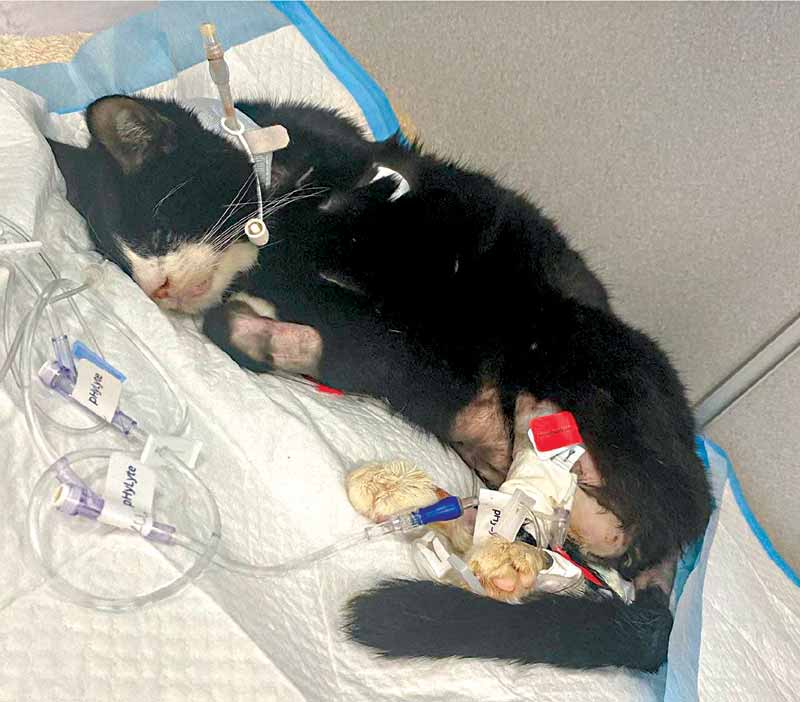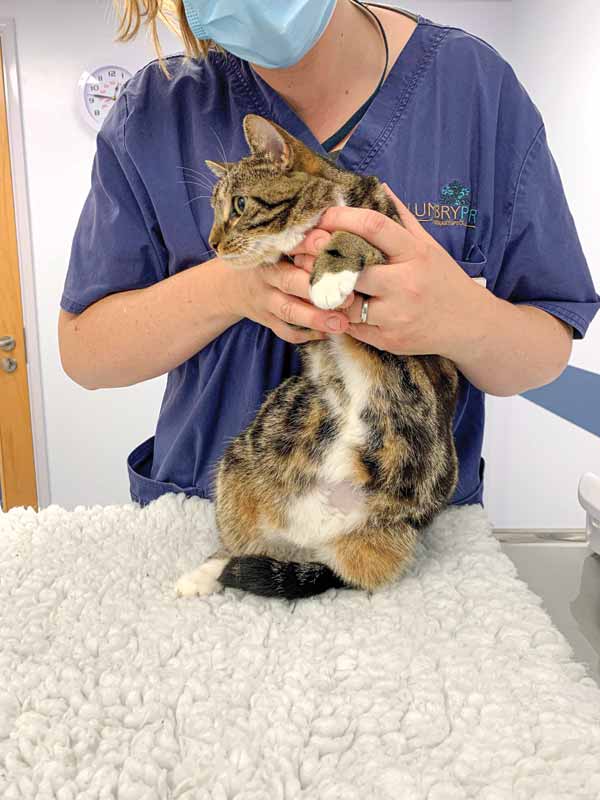
Feline infectious peritonitis (FIP) has historically been common and fatal—one in every 200 new feline cases at American veterinary teaching hospitals presents with the virus,1 and nearly all cats that develop FIP will die from the disease.2
First described as a specific disease in 1963,3 FIP was a death sentence and a major cause of mortality in kittens under one year of age for decades. It is caused by feline coronavirus, which is an RNA virus, and pivotal tests in 2019 for a class of antivirals (nucleoside analogs) that includes remdesivir (GS-5734) and GS-441524, showed promise in treating FIP in felines. These drugs disrupt viral replication and result in high rates of survival when used to treat the following forms of the virus:
- Effusive (“wet”). Fluid may accumulate in the abdomen, chest, and occasionally around the heart.
- Noneffusive (“dry”). Any organ can be affected, including intestines, lymph nodes, brain, kidneys, and eyes.
- Neurological. If the brain or spinal cord is affected, cats will show signs, such as seizures, an abnormal way of walking (wobbly gait), changes in behavior, or trembling.
- Ocular. The eyes may look cloudy, bloody, or present with different pupil sizes, and may show signs of pain, such as holding the eye or closing it.Many cats have a combination of forms of FIP; for example, neurological cases can have an effusion.Veterinarians in Australia were first able to legally prescribe this new class of antiviral drugs in 2020, while in the UK, human remdesivir became legally available for veterinary use in 2021—proving highly effective but cost-prohibitive and painful if injected subcutaneously. Over a half million units of legally prescribed FIP products have been prescribed since their launch in Australia and the UK. (Table 1)
UC Davis trials, 20194 – 31 cats Australian study—28 client-owned cats5 UK study—307 cats6 UK study (Royal Vet College)—32 cats7 Cats with effusive or dry-to-effusive or non-effusive FIP treated with GS-441524 at a dosage of 2.0 mg/kg for >12 weeks. · 77 percent survival rate
Remdesivir injections followed by GS-441524 tablets · 83 percent survival rate at 18 months
·92 percent if patients survives the first 48 hours
· 84.4 percent overall complete response · 4.9 percent relapse during treatment
· 6.6 percent relapse after treatment
Retrospective study of 32 client-owned cats with effusive or non-effusive FIP. · 87.5 percent clinical response
· Minimal adverse effects
Without vet’s guidance and quality control
Meanwhile, in the United States, word of GS-441524 success spurred a sizable black market for pet owners looking to save their cats’ lives. U.S. veterinarians’ hands were tied, and they could not help advise clients and prescribe medication. The groundswell of information sharing, both in the international veterinary community and in social media for pet owners, undoubtedly saved many lives.
The interest in and need for an effective and safe treatment for FIP are clear: one Facebook FIP group has 70,000 members, and another has 26,000. A group of UK feline specialist vets has answered over 2,500 emails from around the world about the novel treatments and continues to be contacted for advice.
Samantha Evans, DVM, PhD, DACVP, of the Colorado State University, has been studying the unlicensed use of GS-441524 since 2020 and estimates around 100,000 cats have been treated with black market drugs in the U.S., largely without the guidance of vets. “The irony is, the first cats cured of FIP back in 2016 were in California, and until now, there has never been a regulated drug available to veterinarians in the U.S.,” says Dr. Evans. “It’s really high time for us in the world of FIP in the U.S.” (Figure 1)

Courtesy Stokes Pharmacy Black market, unauthorized use of drugs for FIP treatment without the oversight of veterinarians, and appropriate veterinary pharmacy quality controls have undoubtedly saved lives, but at a cost. Pet owners searching for answers on social media and participating in parking lot drug exchanges to treat their cats without the help of a veterinarian still saw success. Still, those drugs have a high degree of variation in potency and lack clear instructions for use.
In a February 2024 study,8 every single unlicensed “GS-441524” drug tested contained the nucleoside analogue antiviral drug, but there was considerable variation in the content, particularly in oral formulations—on average 75 percent more for those with higher-than-expected potency, and an average of 39 percent less for those of lower potency, demonstrating clear and significant quality control issues. Overly high concentrations of drugs can result in potential adverse events, including forming urinary stones, which has not been reported with compounded drugs.
Labeling of these black-market drugs has also proven to be an issue for the proper treatment of FIP. Their oral formulation is often labeled by the presumed amount absorbed into the body, which assumes a certain bioavailability, and on a per-kg of cat basis, leaving much room for error when treated by a layperson.
Treatment options today
May 10, 2024, was a pivotal point in treating FIP. Until the U.S. Food and Drug Administration (FDA) announced its position on the use of compounded GS-441524, veterinarians were concerned with potential threats to their licenses and legal and financial penalties for recommending or prescribing treatment for FIP. As no FDA-approved drug is available to treat FIP in cats, the FDA announced it does not intend to enforce new animal drug approval requirements9 for products compounded from GS-441524 when prescribed by a veterinarian for a specific cat patient for treatment of FIP under the conditions listed in Guidance for Industry (GFI) #256.
The drug is under review for bulk drug substances and is allowable for office use while under review in most states as of press time. Even in one of the nine states that do not allow bulk drug dispensing, overnight shipping from a compounding pharmacy for patient-specific prescriptions has shown promising results in treating these cases.
Human-use medicine, such as remdesivir, does not have to be a veterinary formulation to be prescribed off-label by veterinarians for animal patients. However, because it is more difficult for vets to get is a painful course of treatment for patients, attention turned to GS-441524 as the path to getting cats in the U.S. effective and prescribable treatment.
Veterinarians now have accessible treatment options for FIP, and building on the pioneering work of feline specialist vets in Australia, the UK, and the U.S., can offer new hope and clear guidance to clients whose cats present with FIP.

FIP was once a death sentence, but new antivirals like remdesivir (GS-5734) and GS-441524 offer hope. Photo courtesy Samantha Taylor, BVetMed(Hons), CertSAM, DipECVIM CA MANZCVS, FRCVS What’s next for FIP diagnosis and treatment
With a new path forward to treat FIP, vets may now need to set strategies for diagnosing FIP, which presents challenges, as a single definitive and minimally invasive diagnostic test remains elusive.
Previously, the gravity of decisions related to euthanasia argued for caution. Now, veterinarians may have the opportunity to treat FIP early, and empiric therapy with GS-441524 can be used to support the diagnosis in a patient that is strongly suspected to have FIP. Over-treatment, however, must be avoided as viral resistance to these effective drugs would be extremely concerning. Therefore, it is critical to pursue additional diagnostics in cases that do not respond to antiviral therapy, as there are many feline diseases which can imitate the clinical signs and laboratory results of FIP.
With continued research, we expect great strides to come in practical, affordable diagnosis and treatment of FIP in cats in the coming years.
Emmett McVey, RPh is the pharmacist-in-charge and co-owner of Stokes Pharmacy. McVey holds a pharmacy degree from the Temple University School of Pharmacy in Philadelphia, Pa. As a dedicated pharmacist with over 35 years of experience, McVey has been committed to providing pharmaceutical care, ensuring all patients receive the highest quality of service and medication management. In addition to managing Stokes, Emmett is a licensed consultant pharmacist who offering expert advice on medication therapy management, regulatory compliance, and patient care optimization.
References
- Hartmann, 2005 https://www.ncbi.nlm.nih.gov/pmc/articles/PMC7114919/
- Merck Veterinary Manual, https://www.merckvetmanual.com/cat-owners/disorders-affecting-multiple-body-systems-of-cats/feline-infectious-peritonitis-fip
- Pedersen, 2022 https://ccah.vetmed.ucdavis.edu/sites/g/files/dgvnsk4586/files/inline-files/Review%20FIP%201963-2022%20final%20version%20April%202022.pdf
- Efficacy and safety of the nucleoside analog GS-441524 for treatment of cats with naturally occurring feline infectious peritonitis, N. Pedersen, M. Perron, H. Liu https://journals.sagepub.com/doi/full/10.1177/1098612X19825701
- Outcomes of treatment of cats with feline infectious peritonitis, S. Coggins https://pubmed.ncbi.nlm.nih.gov/37439383/
- Retrospective study and outcome of 307 cats with feline infectious peritonitis treated with legally sourced veterinary compounded preparations of remdesivir and GS-441524 (2020-2022), S. Taylor https://pubmed.ncbi.nlm.nih.gov/37732386/
- Thirty-two cats with effusive or non-effusive feline infectious peritonitis treated with a combination of remdesivir and GS-441524, J. Green, H. Syme, S. Tayler https://pubmed.ncbi.nlm.nih.gov/37403259/
- https://avmajournals.avma.org/view/journals/javma/262/4/javma.23.08.0466.xml
- https://www.fda.gov/animal-veterinary/cvm-updates/fda-announces-position-use-compounded-gs-441524-treat-fip
